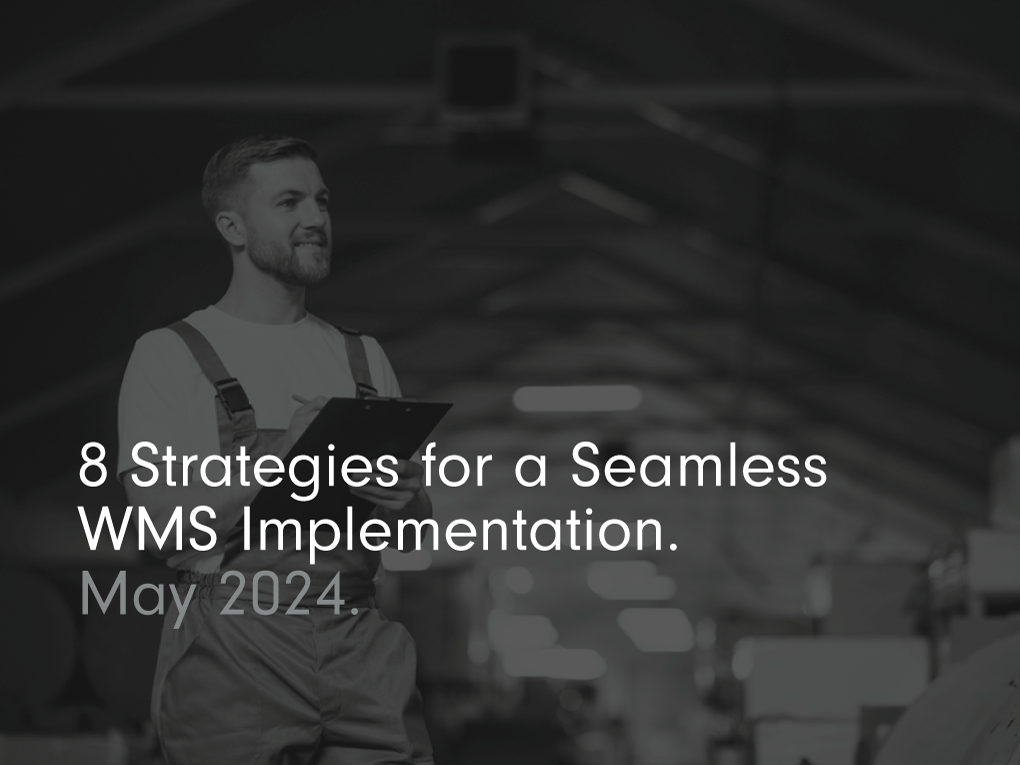8 Strategies for a Seamless WMS Implementation.

Implementing a Warehouse Management System (WMS) is a critical step for any warehouse seeking to boost efficiency and streamline operations. However, the process can be challenging and complex. Here, we outline eight actionable steps to ensure a successful WMS implementation.
Whether you are a Warehouse Manager, Logistics Professional, or Supply Chain Analyst, this WMS Implementation Guide/Checklist will help you lay a strong foundation for success.
1. Define Goals.

The first step in your WMS implementation journey is to define clear goals. This involves understanding the specific needs of your warehouse and setting clear objectives. Without well-defined goals, it becomes challenging to measure the success of your WMS and ensure it aligns with your overall business strategy.
Actionable Steps:
Conduct an In-Depth Analysis:
- Assess your current warehouse operations to identify bottlenecks and areas for improvement. This might involve examining flow processes, storage solutions, and labour productivity.
- Analyse KPIs to pinpoint inefficiencies. Key Performance Indicators such as order accuracy, cycle time, and inventory turnover can provide valuable insights into your warehouse’s performance.
Set SMART Goals:
- Define Specific, Measurable, Achievable, Relevant, and Time-bound (SMART) goals. These goals should be detailed and realistic to ensure they are attainable and can be tracked over time.
- Align these goals with your warehouse’s long-term objectives. For instance, if your long-term objective is to reduce costs, a short-term SMART goal could be to decrease picking errors by 10% in the next quarter.
- Talk with your team to ensure everyone understands and commits to these goals, creating an atmosphere that supports ongoing improvement.
Define an Internal Project Manager:
- Appoint an internal project manager who can work closely with stakeholders and the implementation team. This person will coordinate activities, meet goals, and serve as a bridge between departments and partners to ensure clear communication and teamwork.
2. Select the Right System.

Choosing the right Warehouse Management System (WMS) is crucial for the efficiency and productivity of your operations. It should cater to your warehouse’s specific needs and be scalable, user-friendly, and compatible with your existing systems. The right WMS can streamline your processes, reduce errors, and enhance overall performance.
Actionable Steps:
Research and Compare Options:
- Compile a list of potential WMS solutions that align with your business requirements. Build a Request for Proposal (RFP) to send to potential vendors.
- Evaluate each option based on scalability, integration capabilities, cost-effectiveness, and user-friendliness.
- Consider reading reviews and testimonials from other businesses in your industry to gauge the effectiveness of each WMS vendor.
Engage with Providers:
- Arrange demos and consultations with WMS providers to get a hands-on understanding of how each system operates.
- Ask detailed questions to determine the best fit for your warehouse needs, including customisation options, support services, and training programs.
- Request case studies or references from existing clients to validate the provider’s claims and ensure their reliability.
By following these steps, you can make a well-informed decision that will support the long-term success of your warehouse operations.
3. Team Preparation.

Preparing your team for the new Warehouse Management System (WMS) is essential. This preparation includes identifying key stakeholders, providing comprehensive training, and clearly defining roles and responsibilities. A well-prepared team can significantly reduce the risks associated with WMS implementation and ensure a smoother transition.
Actionable Steps:
Identify a Dedicated Team:
- Select team members from various departments, including key stakeholders, IT personnel, and end-users who will be directly affected by the new WMS.
- Clearly define roles within this team to ensure accountability and streamlined communication.
Provide Comprehensive Training:
- Organise training sessions on WMS functionality, industry best practices, and troubleshooting techniques.
- Utilise simulations and hands-on practice sessions to ensure team members thoroughly understand the system and can operate it effectively.
- Offer follow-up training and resources to address any emerging questions or issues.
4. Data Clean-Up.

Data accuracy is vital for a successful WMS implementation. Ensuring your existing data is clean, accurate, and well-organised will lay a strong foundation for the new system. Clean data helps in avoiding errors and inefficiencies that can arise from incorrect or outdated information.
Actionable Steps:
Assess and Clean Up Data:
- Conduct a thorough review of your current data to assess its accuracy and relevance to the new WMS requirements.
- Correct any errors identified and remove outdated or redundant data that could clutter the new system.
- Ensure data consistency and integrity across all records.
- Plan and execute data migration to ensure accurate transfer to the new system.
Develop a Data Maintenance Strategy:
- Establish clear protocols for maintaining data accuracy and integrity on an ongoing basis.
- Schedule regular data audits and reviews to ensure continued accuracy and relevance.
- Regularly data backups to prevent loss and ensure data recovery in case of system failures.
5. Implementation Plan.

A detailed implementation plan is the backbone of a smooth WMS transition. This plan should break down the entire process into manageable tasks, each with clear timelines and responsibilities. A well-structured plan helps in tracking progress and addressing potential issues proactively.
Actionable Steps:
Create a Project Plan:
- Outline the entire implementation process, specifying detailed tasks, timelines, and responsible parties for each task.
- Include milestones and checkpoints to monitor progress and make adjustments as necessary.
Include Risk Assessment:
- Identify potential challenges and risks that could impact the implementation process.
- Develop mitigation strategies to address these risks, including resource allocation for risk management.
- Communicate the risk management plan to all stakeholders to ensure preparedness.
6. Testing and Feedback.

Thorough testing and user feedback are crucial components of a successful WMS implementation. Rigorous testing ensures the WMS works as intended, while user feedback provides insights into its functionality and usability.
Actionable Steps:
Conduct Thorough Testing:
- Test the system in a controlled environment to identify and resolve any issues before full deployment.
- Simulate various scenarios and workflows to ensure the system can handle different operational situations robustly.
- Document test results and address any identified issues promptly.
Gather User Feedback:
- Solicit feedback from end-users regarding system functionality, usability, and overall user experience.
- Use surveys, focus groups, and one-on-one interviews to gather comprehensive insights.
- Incorporate feedback into final preparations and adjustments to ensure the system meets user needs and expectations.
Follow these steps for a smoother WMS implementation process, boosting efficiency and productivity in your warehouse.
7. Go-Live and Support.

The go-live phase is when we officially switch to the new Warehouse Management System (WMS). This important step needs careful planning and preparation to ensure a smooth transition. It’s crucial to have support systems ready to handle any issues and reduce downtime quickly.
Actionable Steps:
Schedule Go-Live During Low Activity:
- Carefully choose a period of low activity in your warehouse operations to minimise disruptions and reduce the risk of complications.
- Ensure all necessary resources, including staff and technical support, are on standby to manage any unforeseen challenges.
Establish a Support System:
- Make sure your WMS provider offers a specialised support team, ready to tackle technical and operational problems during and after the switch.
- Set up easy-to-use ways for reporting issues, like a help desk or support hotline, to quickly solve any problems.
8. Monitoring and Optimisation.

Continuous monitoring and optimisation are key to maximising the benefits of your new WMS. This phase involves tracking system performance, identifying areas for improvement, and making necessary adjustments to enhance efficiency and productivity.
Actionable Steps:
Implement a Monitoring System:
- Establish a robust monitoring system that tracks key performance indicators (KPIs) and metrics to evaluate the WMS’s effectiveness.
- Regularly analyse this data to identify patterns, bottlenecks, and areas for improvement and optimisation.
Regularly Review and Gather Feedback:
- Conduct periodic reviews of WMS usage and performance, involving all relevant stakeholders, including warehouse staff and management.
- Collect feedback from users to understand their experiences and identify any issues or areas for enhancement. Use this feedback to make continuous improvements to the system.
Conclusion.
Implementing a WMS smoothly can greatly improve your warehouse’s efficiency and productivity. Follow this WMS implementation checklist for success: define your goals, pick the right system, prepare your team, clean up your data, make a detailed plan, test thoroughly, ensure a smooth start, and keep monitoring.
A well-done WMS implementation can keep you competitive in the quick-moving logistics world. For more tips and support, check out our detailed WMS implementation steps and resources.
Thinking about upgrading? Get in touch with us to find WMS solutions that fit your warehouse’s specific needs and boost your operational efficiency.
Frequently Asked Questions.
A Warehouse Management System (WMS) is software that helps manage warehouse operations. It automates tasks like inventory tracking, order processing, and storage management. By providing real-time data, a WMS boosts efficiency, accuracy, and productivity.
Key features of a WMS include inventory control, order picking, batch picking, real-time tracking, and storage optimization. Benefits include:
- More accurate inventory and fewer stockouts.
- Real-time updates.
- Faster order processing and fulfilment.
- Better use of warehouse space and lower costs.
- Reduced human error in operations.
- Enhanced supply chain management and visibility.
Businesses of any size or industry that manage significant inventory can benefit from a WMS. This includes retail, manufacturing, third-party logistics (3PL), and e-commerce companies. Any organization aiming to improve warehouse operations and supply chain efficiency can leverage a WMS.